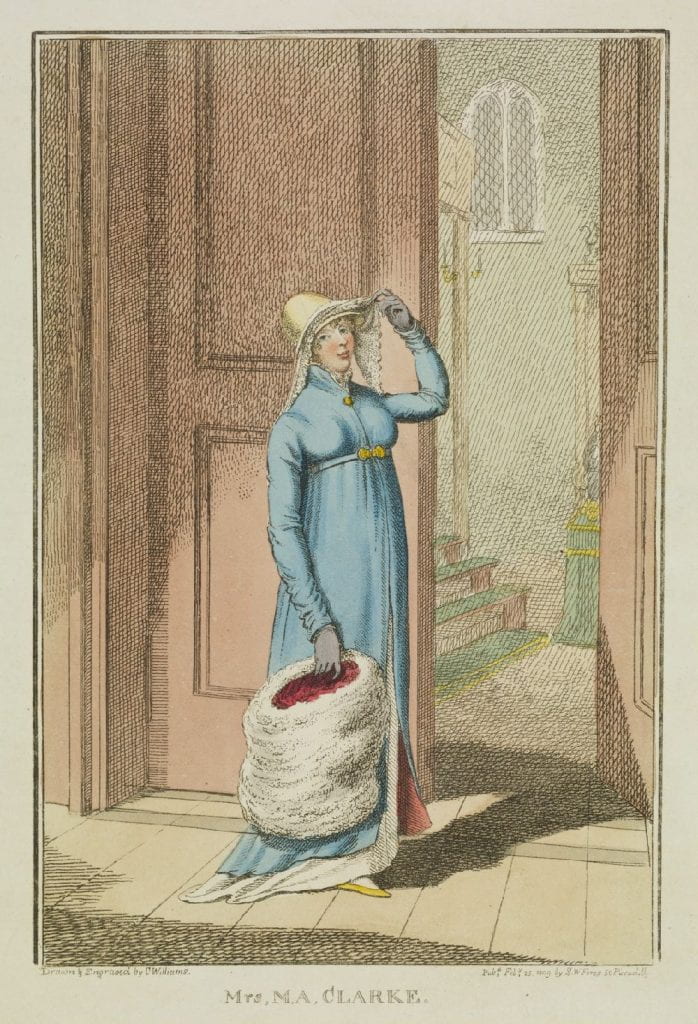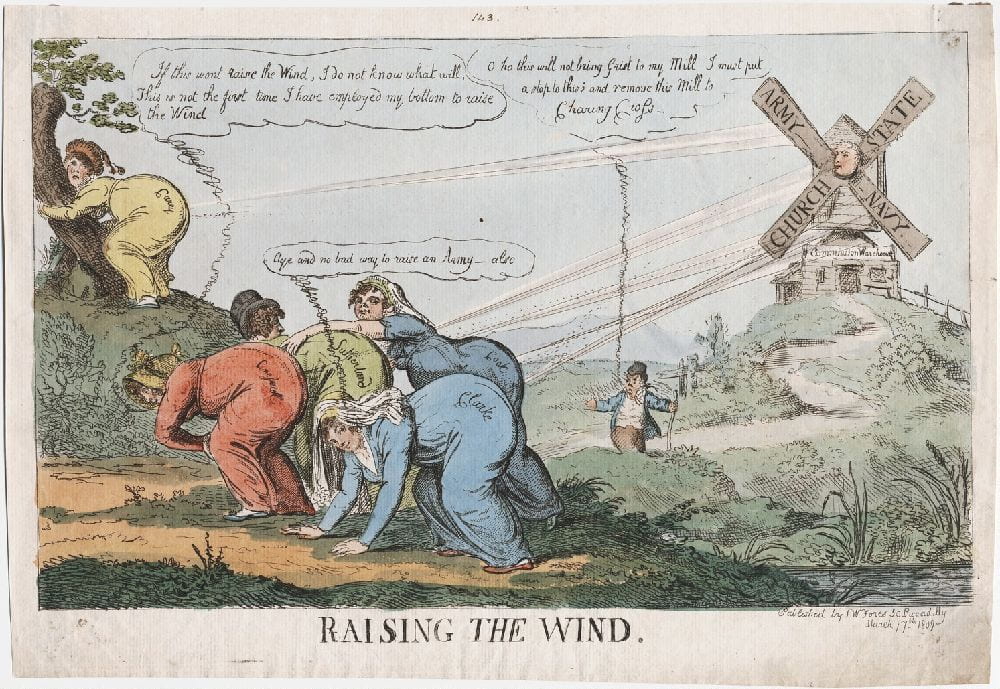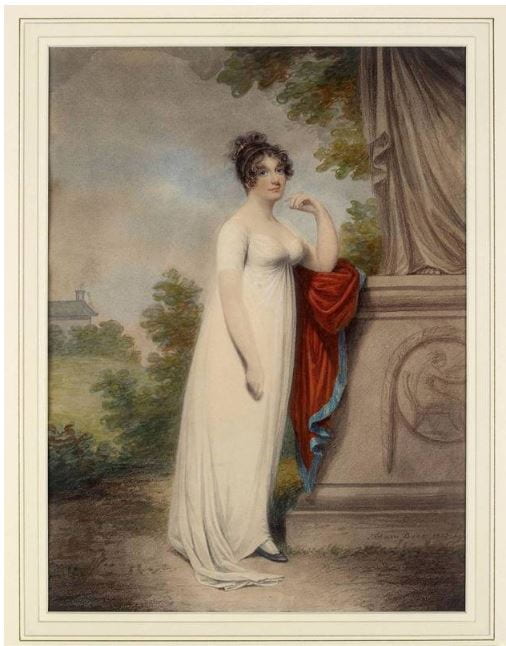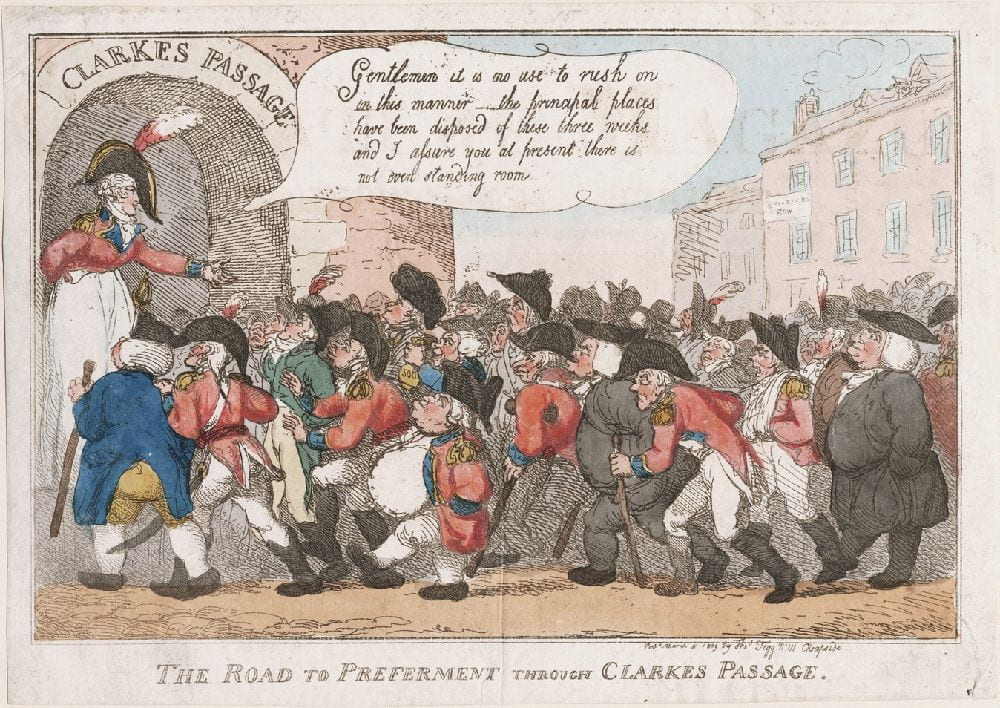by Laura Engel, Professor of English, Duquesne University
Mary Anne Clarke, scandalous mistress of the Duke of York, directed, starred, and costumed her life as if it were an eighteenth-century play. Except it wasn’t. Born to a tradesman in Covent Garden, Clarke used her wit, looks, and charm to work her way up the ranks of British society, eventually hooking up with one of the Royal sons. To bankroll her desire to furnish a townhouse, the two invented a scheme to sell army commissions to the highest bidders. Ultimately, they were exposed, and Clarke testified against the Duke before the House of Commons in 1809 wearing a blue dress and carrying a stylish white muff.

Mrs. M.A. Clarke
by Charles Williams
Published February. 25, 1809, by S.W. Fores
The Lewis Walpole Library
809.02.25.03
I first encountered Mary Anne Clarke through a series of images at the Lewis Walpole Library – portraits of her as a fashionable glamour girl in neo-classical dress alongside scathing caricatures of her by Thomas Rowlandson. Immediately I was struck by the dichotomy of these portrayals – the beauty of the stylish pictures and the virulent, cruel attacks mounted by the caricatures. In one Mary Anne Clarke is breaking wind, in another she is precariously mounted on a seesaw, her legs flying in the air, in another she invites a group of soldiers to “move through her passage.” In all these images she plays a role enacting again and again the archetypal theatrics assigned to seductive and manipulative women.

Raising the wind
Isaac Cruikshank
Published March 17, 1809 by S. W. Fores 50 Piccadilly
The Lewis Walpole Library
809.03.17.01+

A general discharge, or, The darling angel’s finishing stroke
by Thomas Rowlandson
Published March 13th, 1809 by Thomas Tegg, No. 111 Cheapside
The Lewis Walpole Library
809.03.13.01+
Recently, the LWL acquired a new portrait of Mary Anne Clarke that connects the two sides of MAC iconography. A watercolor by Adam Buck from 1804 echoes his image of Clarke from 1803 but differs in important ways. In the 1803 portrait Clarke is posed wearing a lovely white gown and leaning against an antique column. Her hand reaches to touch her cheek, exposing her elbow. She tilts her head slightly back (in a pose favored by contemporary teens doing selfies) and gazes seductively at the viewer. In the 1804 version, MAC is in the same dress in front of a decorative fence with her hand on one hip. She holds the folds of her gown in the other hand, and stares at the spectator with an annoyed expression. The whole image conveys a sense of motion as if MAC is walking off the stage set in a huff muttering “I’m out of here.”

Portrait of a Lady
by Adam Buck
London, 1803
in Connoisseur Magazine, 1915
The Lewis Walpole Library
18 C765

Portrait of Mary Anne Clarke
by Adam Buck
London, 1804
pencil, watercolor and gouache
The Lewis Walpole Library
Drawings B922 no. 1 Framed
If this image is correctly dated, MAC could not have known about the world of trouble and publicity that she would encounter a few years later in 1809. But I’d like to think this portrait conveys a sense of her authentic personality, perhaps a moment where she stepped out of her proscribed role and hustled out for tea.
Recently, I visited the newly renovated National Portrait Gallery in London. There in a very crowded room in a corner flanked by a bust of William Pitt was Lawrence Gahagan’s portrait sculpture of Mary Anne Clarke as Clytie the abandoned lover of the Greek sun god. Undoubtedly most people in the room were more interested in the large coronation portrait of Queen Victoria behind her and walked right by. I wondered if in commissioning the sculpture, which she did to promote her image after the trial, she agreed to be portrayed with her breast exposed, an effect more reminiscent of Lely’s portraits of Restoration actresses than antique sculpture. It also occurred to me that if you look closely Clarke’s expression is wry, her eyebrow arched, in the same mode as the sassy 1804 portrait. She’s challenging us to acknowledge her vitality and her ability to choose her own mode of representation. Things did not end well for Clarke, a fact that is not reflected on the label in the gallery. Her presence on the stage of the museum as a memorial object is connected to an archive of defiant performances quietly hidden in plain sight.

Mary Anne Clarke (née Thompson)
by Lawrence Gahagan
marble bust, 1811
24 3/8 in. x 17 3/4 in. (620 mm x 450 mm) overall
Purchased, 1965
Primary Collection
NPG 4436

